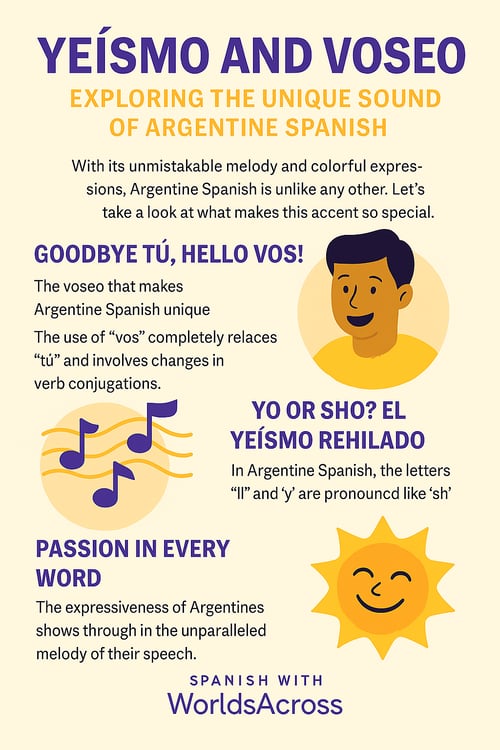Exploring the Unique Sound of Argentinian Spanish

All Latin American accents have something special. From the sensual Colombian accent to the sing-song tone of Mexican Spanish. But there’s one that easily stands out among the rest. Do you know which one it is? That’s right—the Argentine accent! With its unmistakable melody and colorful expressions, Argentine Spanish knows how to steal hearts and delight the ears of everyone who hears it. If you want to learn more about the characteristics of this fascinating accent, come along and let’s explore them together!
Goodbye “tú,” Hello “vos”! The Voseo That Makes Argentine Spanish Unique
If you’ve ever had the chance to hear an Argentine speak, you probably noticed something fascinating: the word “tú” is almost nonexistent in their vocabulary. Why? Because of the famous voseo! This linguistic phenomenon is much more than just replacing “tú” with “vos.” It’s a distinctive feature, a spark that gives a warm, special touch to conversations.
And as if that weren’t enough, voseo also completely changes verb conjugations! For Spanish learners, this is an exciting and intriguing challenge that adds an extra layer of beauty and uniqueness to the language.
For example, instead of saying “¿Tú quieres comer?” an Argentine would say “¿Vos querés comer?” Or, instead of “Tú sabes de qué estoy hablando,” they would say “Vos sabés de qué estoy hablando.” Interesting, right? Argentine Spanish is truly one of a kind!
A Musical Journey: Discover the Unique Rhythm of the Argentine Accent
One thing you definitely can’t say about the Argentine accent is that it’s boring or monotonous. Unlike other Latin American accents that may sound flat or neutral, the rhythm of Argentine speech constantly rises and falls—very similar to how Italians speak. In fact, that similarity is no coincidence; it’s the direct result of European immigration in the late 19th century, when a massive wave of Italians arrived in Argentina and left a deep imprint on the language.
Another standout trait of Argentine Spanish is the rising intonation at the end of sentences. This particular musicality adds a sense of enthusiasm or emphasis. Just imagine talking to someone who seems to lift their tone at the end of every sentence—it's a fun experience for the ears!

Yo or Sho? El Yeísmo Rehilado
When it comes to the features that give Argentine Spanish its unique essence, yeísmo rehilado is without a doubt one of the most distinctive. This linguistic phenomenon changes the way the letters “ll” and “y” are pronounced—completely different from how they sound in most other Spanish-speaking countries.
While in places like Mexico or Colombia you might hear “calle” and “lluvia” with a soft “y” sound, Argentines replace that with a “sh”-like sound. Here are some examples:
- “Ya está lloviendo” becomes “Sha está shoviendo”
- “Yo sé cómo te llamas” becomes “Sho sé cómo te shamás”
- “Ayer salí con ella y llegó tarde” becomes “Asher salí con esha y shegó tarde”
Fascinating, right? Why not give it a try? Make a list of phrases that include the letters “ll” and “y”, and replace them with “sh” to practice sounding like a true Argentine. Sho sé que vos podés!
Passion in Every Word: The Incomparable Expressiveness of Argentines
Without a doubt, the unmatched melody of Argentine Spanish is deeply tied to its culture. Argentines are synonymous with expressiveness and emotion. In other words, they know how to put their heart into everything they do—and of course, their way of speaking is no exception. Their speech goes beyond simple sentences; it’s a way of expressing their cultural passion and personality.
Typical Phrases and Common Expressions
If you’re already loving the voseo, the rising intonation, and Argentine expressiveness, wait until you hear some of their most common phrases and expressions. You’ll love them! Here are a few of the most popular:
- Che
Used to get someone’s attention or simply as a friendly way to address someone.
Example: “Che, ¿Qué hacés? Acompañáme a la tienda.”
(Hey, what are you doing? Come with me to the store.) - Laburar
A classic in Argentine Spanish. “Laburar” is a colloquial way to say “to work.”
Example: “Mañana es domingo, y me toca laburar todo el día.”
(Tomorrow is Sunday, and I have to work all day.) - Re + adjective
The prefix “re” is used to intensify an adjective, like “very” or “super.”
Example: “Estoy re-contento.”
(I’m really happy.) - ¡Andá!
Used to express surprise or disbelief, like saying “No way!”
Example: “¿Te vas a casar? ¡Andá!”
(You’re getting married? No way!) - Boludo / Boluda
A word that should be used with caution. Depending on the context, it can be a friendly expression or an insult.
Example: “¡No seas boludo!”
(Don’t be silly / Don’t be stupid.)
After discovering just how special the Argentine accent is, you’re probably already craving a good mate while replacing “ll” and “y” with “sh.” Every word and every phrase shows that Argentine Spanish is more than just a language—it’s a way of life and expression.
So now you know! The next time you hear a “che” or a “boludo”, get ready! You’re about to dive into a conversation full of emotion and energy. ¡Nos vemos, che!





